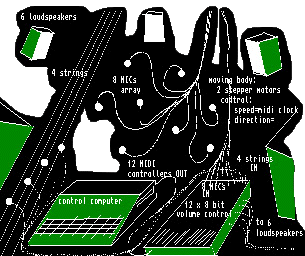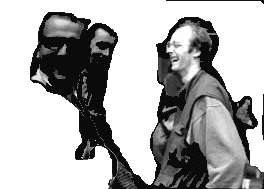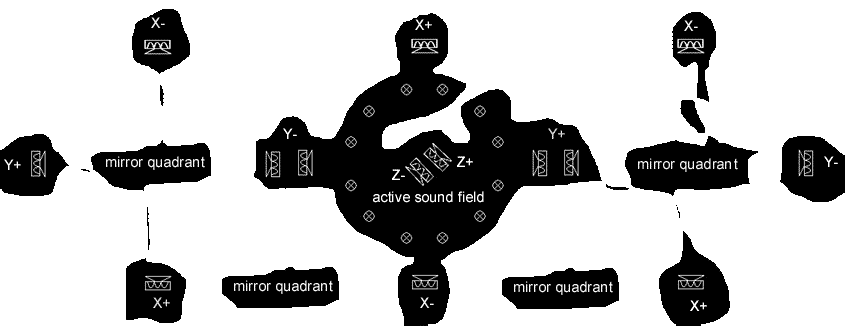 |
 |
 |
 |
 |
 |
| INTRODUCTION
TO THE CONCEPT...
BIOTOPE
is a dynamic listening and performative environment; a system of three
dimensional sound control. Conceived and developed by sound artists Borut
Savski (Slovenia) and John Grzinich (USA), the BIOTOPE project explores
the possibilities of how an installation may act as a medium for a human-mechanical-audio
system relationship. Installation will be premiered in June (14th to 28th)
1999 in Kapelica Gallery, Ljubljana/
Slovenia - therefore the pictures of it are not available till then.
The idea of using acoustically fed-back microphones goes back to 1994.
John and Borut met at ARS ELECTRONICA 98 for the first time and found common
grounds in certain principles which now result as a BIOTOPE project.
SYSTEM's METAPHORES... The BIOTOPE project has grown out of the artists' interest in developing models of general systems and theories of autopoietic, or self-referencing systems as they relate to biology, technology and the social sciences. The systems model states that: "life is a system of self-organization, a developmental unfolding at progressively higher levels of differentiation and organized complexity. [This process], more over, is dynamic rather than static, open not closed and searches spontaneously and actively for stimulation rather than passively waiting to respond."(Bertalanffy, 1952). This is furthered by autopoietic theory, adding the cognitive field of the observer, which is "a consequence of circularity and complexity in the form of any system whose behavior includes maintenance of that selfsame form." (Maturana & Varela, 1980). These ideas have had a significant impact on restructuring many areas of scientific research in the last half of this century, yet remain unfamiliar to much of the general public. The BIOTOPE project is not an attempt to simulate life (as does artificial intelligence). It is an exploration the qualitative value of congruent change in system interactions which becomes the aesthetical imperative of the artist and the observer. In the whole of this complete audio environment, the listener as 'cognifier' becomes as much an aspect of the system as does the creator. The BIOTOPE system allows the visitor to enter the dynamic process via sound - sound field is the cohesive element. SOLUTIONS... In Physics thermodynamic model defines a model of a self-contained, 'isolated' system, where the sum of all energies present (kinetic, potential and internal -> of the molecules) remaining CONSTANT, while at the same time a lot of ACTIVITIES may be going on inside. A jump to human systems: what we - the elements/particles (either individual or small systems) PERCEIVE is this very localized activities - the energy changing its various forms (internal to potential to kinetic to... poetic?). What we cannot see is the system as a whole - the EYE from outside (above?). The model of TIME is represented as a SERIES one and is needed to provide a simple and transparent CAUSAL model of the events. This is then HISTORY (and evolution, dialectics... - they all have bodies the way we relate to them: "the history will remember..."). More of this kind of talk... in Slovene & CE English BIOTOPE AS SOCIAL ENVIRONMENT... While one aim is a 'self-sufficient' sound & sound events producing mechanism, no less important complementary aim is to inhabit/appropriate it by humans/artists. In this case the mechanism acts as a 'not too predictive' (complex?) instrument for the human 'inhabitants' to upgrade. Upgrading it with their ability to form social relations/organisation. Isn't this an important aspect of life that boasts to be intelligent? |
'INHABITANTS'...
It
is a well known fact that public places of relative size that are adequate
for electroacoustic sound installations are rarely available - as are already
configured systems that are open for explorations. The BIOTOPE installation
therefore proves to be more of a working environment (-> 'work in process'
as M. Kosnik puts it) than a finished object of passive admiration. Apart
from the two authors, there were three artists 'inhabiting' it/ testing
it:
ELEMENTS... Generators:
Perturbators:
Accumulators
and Accelerators:
John
Grzinich (b. 1970) has used wire-based devices, field recordings
and processed electronics to create sound elements for performance and
studio work since 1993. His interest in sound stems from studies
of architecture and design and their relationship to spatial perception
and the human environment. Numerous projects
and
collaborations
in the field of installations, performances in USA and Europe, including
a vital part in Orogenetics initiative in Austin/Texas.
Borut
Savski (b. 1960) is an 'engineering soul straying away from any
regulated use of technological, social, media and aesthetic principles'.
His studies of electronics and radio production work (from
1983) allowed for experimentation with sound and related media. In
1991 he began collaborating with artist Marko Kosnik on projects of the
Egon
March Institute. Over the past two years he has broadened his
work from local to international activities related to the internet as
media and independent radio as public broadcasting space. He currently
hosts a regular
broadcast of experimental sound art at Radio
Student Ljubljana and is a 'keeper' of MINISTRY
OF EXPERIMENT media laboratory.
|
|
A PICTURE TELLS MORE... A pictorial
description of the 'quadrant' modular logic:
|
SYSTEM's RESOURCES: 8 microphones,
4 strings/ wires, pickups, MIDI_to_Voltage interface, voltage controlled
mixing desk, microphone_to_movement elements, Amiga computer, audio compressor
modules...
|
 |
 |
KAPELICA 17th June - Ludwig Zeininger
KAPELICA 18th June - B. Savski
KAPELICA 21st June - B. Savski